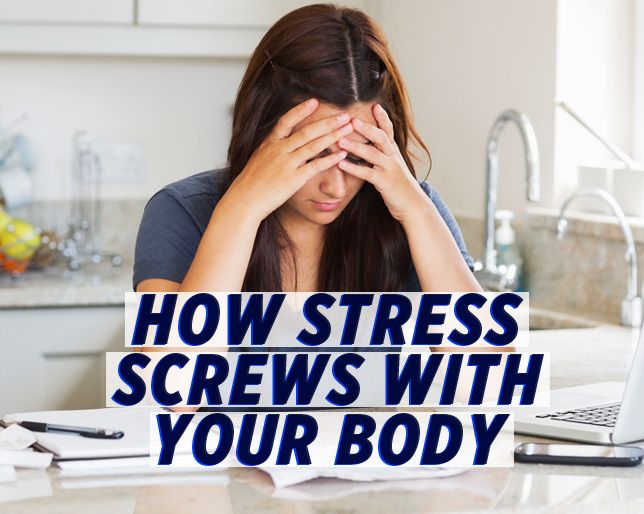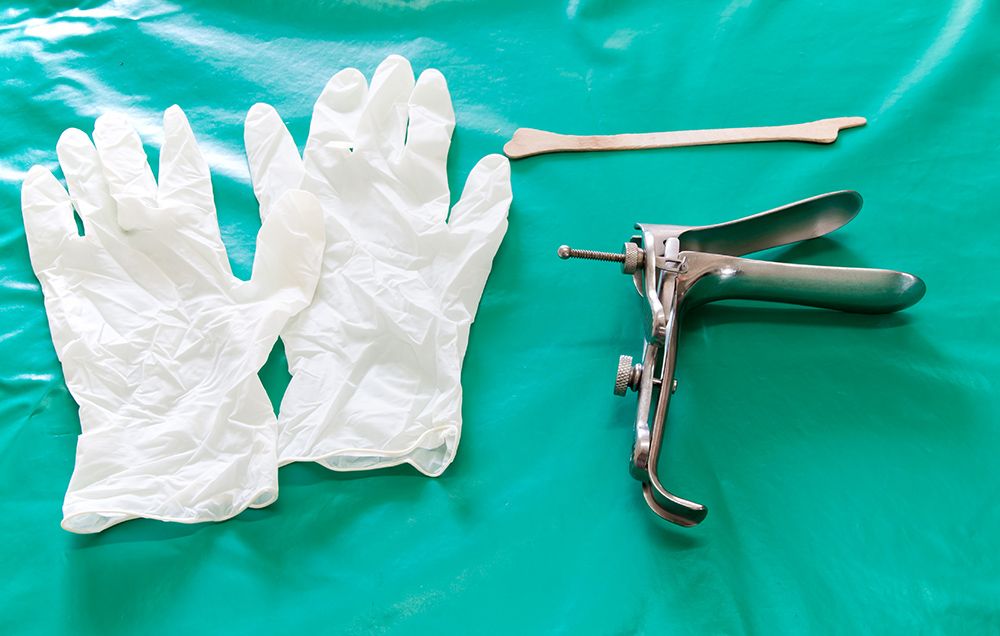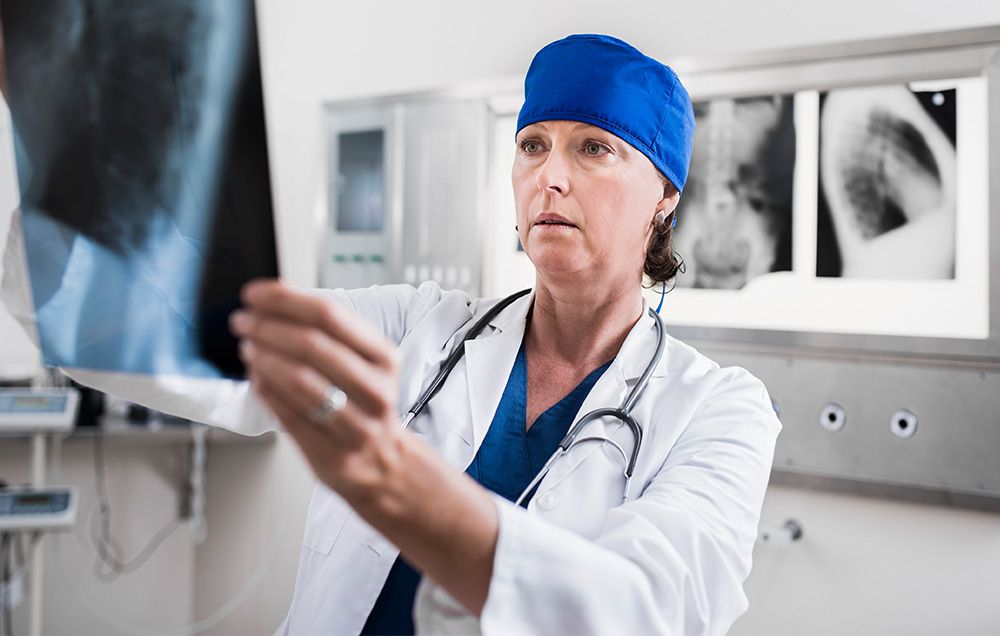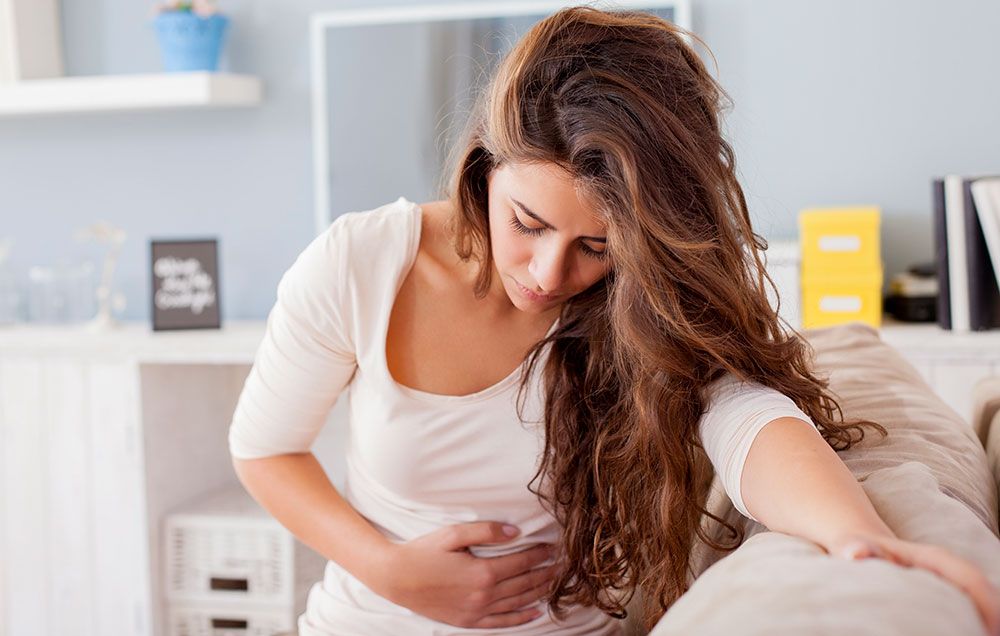Home » Health News »
Cramping But No Period? This Is When To See Your Doctor
You’ve been seriously bloated, moody, and tired—and you’ve got monster cramps. In other words, you’re suffering from all of the classic period symptoms…but your period is totally MIA.
First: don’t freak. There’s a laundry list of reasons (and some are really no big deal) behind why those tell-tale menstrual cramps are plaguing you, but there’s no period along with ’em.
“Hormonal changes related to ovulation can affect some of the same pathways in your brain that might be affected by other medical conditions, causing mood swings that feel similar to your period but aren’t related to ovulation or menses,” says Chailee Moss, MD, an ob-gyn at Johns Hopkins Medicine. What’s more, some physical abnormalities in your uterus and ovaries can also cause cramping that feels like typical symptoms of PMS, she adds.
The thing is, because there are so many different reasons behind cramps with no period, you should never be shy about bringing them up with your doctor if you’re concerned. (It’s always wise to be your own health advocate!)
But it’s still helpful to get familiar with the possible causes, so keep reading for a comprehensive list to help you narrow down what might be fueling your cramps.
1. Anovulation
Every once in a while, your body goes through all of the hormonal changes associated with pre-menstrual syndrome (PMS) but doesn’t actually release an egg that month. This is known as an anovulatory cycle. And if you do not release an egg during a cycle, you won’t actually get your period (but you could still get the cramps).

Anovulation is more common than you might think: “Ten to 18 percent of all regular cycles are anovulatory,” says Chicago-based ob-gyn Jessica Shepherd, MD. An anovulatory cycle can happen randomly on occasion, or it may be related to another issue, like nutrition, body weight, or you’re getting close to menopause.
While skipping a period every now and then is usually nothing to worry about, if you have a fever, significant nausea or vomiting, or pain that you can’t control with simple OTC medications or that doesn’t improve within a week, check in with your doctor right away.
Otherwise, it’s also time to see your doc if you skip more than three cycles in a row, says Dr. Shepherd.
2. Pregnancy
If you’ve had unprotected sex in the last month, were a bit lax about taking your pill, or rely on the pullout method for birth control, it’s worth taking a pregnancy test. Many of the symptoms of early pregnancy, including breast tenderness, mood swings, fatigue, and (you guess it) cramping, mimic the symptoms you typically have before and during your period.
3. Thyroid conditions
Your thyroid, a small butterfly-shaped gland in your neck, regulates many of your body’s functions, including your metabolism and menstrual cycle. If your thyroid gets out of whack, your cycles can become irregular, says Dr. Shepherd. As a result, you may you go a long stretch without having your period while still experiencing period-like cramps, adds Dr. Moss.

Because your thyroid regulates your brain function, mood swings that you thought were part of PMS may be related to your neurologic function, she explains. And spotting or cramping may occur because the lining of your uterus has built up but hasn’t shed because you’re not ovulating.
Be sure to check in with your doctor if you’re experiencing other symptoms of a thyroid condition, including sudden unexplained weight loss or gain, shaking, heart palpitations, or significant fatigue.
4. Hormonal birth control
One very common side effect of hormonal IUDs is skipped periods. That’s because one of the ways the device prevents pregnancy is by thinning out the endometrial lining in your uterus so there’s nothing to shed come that time of the month.
And, while they don’t typically nix your flow altogether, birth control pills can result in super-light flows or spotting. So you might feel period symptoms, like cramps and breast tenderness, even without a heavy, full-blown period, says Dr. Shepherd.
5. Stress
Stress is a surprisingly common reason for missing your period. “Stress increases your cortisol levels, which affects your hormone balance,” says Dr. Shepherd—including the hormones that regulate your ovaries and uterine lining. But, you still might feel crampy.

Exams, deaths, and even breakups are all big-time stress-inducing events that can cause periods to go awry. But even more subtle things, like juggling a ton at work, can fuel chronic stress that affects your mind and body, even though you may not realize it.
“Some people don’t realize they’re so stressed, but once they talk about it they realize they are going through something,” says Dr. Shepherd. If you think stress is messing with your periods, talk to your doctor. Therapy, exercise, yoga, and meditation can all help get your stress under control and your periods back on track.
6. Polycystic ovarian syndrome (PCOS)
Frequent skipped periods can be caused by PCOS. “PCOS is a condition in which a patient has an excess of androgens, which are chemicals in the body that affect ovary function, hair growth, weight gain, and sensitivity to insulin,” says Dr. Moss.
PCOS can result in anovulatory cycles and irregular spotting. It commonly causes cysts to grow on the ovaries, which, if they rupture or cause the ovary to twist, can cause pelvic pain that feels a lot like period cramps.
Up to 20 percent of women are affected by PCOS.
Up to 20 percent of women worldwide are affected by PCOS, and it’s more common among women who are overweight or have a mom or sister with the condition, Dr. Moss says. If you think you might be suffering from PCOS, check in with your doctor. While there is no cure, birth control and other medications can help manage symptoms and get your periods back on track.
7. Uterine polyps
You might associate polyps with your colon, but the same small benign tumors can grow in your uterus. “It’s an overgrowth of lining of the uterus,” says Dr. Moss. Polyps in your uterus can cause cramping and period-like discomfort, even when you’re not on your period.
Because polyps can make it harder to get pregnant, and because there is a small risk they may develop into uterine cancer down the line, your doctor will likely want to remove them, most often with a relatively simple procedure known as a hysteroscopy. During a hysteroscopy, a doctor inserts a long tube up through the vagina and into the uterus. The doctor is able to use the scope to both see and cut out the polyps.
8. Ovarian cysts
Every month, your ovaries make several cysts in preparation for ovulation, but only one cyst releases an egg. Although the others usually dissipate on their own by the time you get your period, sometimes one cyst (or more) sticks around.

Cysts can also occur if you have an anovulatory cycle (such as with PCOS). Ovarian cysts often cause no symptoms at all, although they can sometimes trigger period-like pain when you’re not on your period. So if you’re experiencing irregular cramping, don’t hesitate to discuss it with your doctor.
“Cysts in and of themselves aren’t usually a problem,” says Dr. Moss. “But if they get particularly large, they can cause the ovary to twist—a.k.a. an ovarian torsion—which is painful and requires an emergency procedure to save your ovary.”
9. Pelvic inflammatory disease (PID)
Cramping is a common symptom of PID, which is an infection of the uterus, fallopian tubes, or ovaries that typically occurs when sexually transmitted bacteria spread from your vagina to your reproductive organs.

“Sexually transmitted infections such as chlamydia and gonorrhea are the typical culprits of this serious pelvic infection that can lead to pelvic pain and infertility,” says Sherry A. Ross, MD,, an ob-gyn and author of She-ology. “Make sure you’re getting regular STI checks between new sexual partners to ensure you are not a carrier of damaging STIs.”
10. Urinary tract infections (UTI)
One common symptom of a UTI is pelvic cramping, Dr. Ross says. “Other symptoms include frequency, urgency, and pain and burning with urination, as well as bleeding with urination.”
If you think your cramps might be associated with a UTI, head to your ob-gyn or primary care physician ASAP; left untreated, a UTI could turn into life-threatening kidney infection.
11. Mittelschmerz
If you’ve got PMS-like cramping, bloating, and breast tenderness but no period, one reason may be that it’s not *quite* time for your period yet—but it’s coming.
German for “middle pain,” mittelschmerz happens about half-way through your menstrual cycle—around day 14 when you ovulate, says Nicole Scott, MD, an ob-gyn at IU Health. It’s a totally normal experience—affecting about 20 percent of women—and it doesn’t mean anything is wrong, she says.
Since it’s just your ovaries doing their thing, there’s not much you can do to prevent it and the symptoms should go away within a day or two. But if you’re cramping or feeling discomfort that is extremely painful or comes with any sign of infection, call your doc, Dr. Scott adds.
12. Exercising too much
Hitting the gym on the regular is one of the best things you can do to help deal with PMS symptoms. However, working out too hard or too often can actually mess up your cycle, and in some cases make you miss your period all together, Dr. Scott says.

All that physical stress, especially if you lose a lot of body fat, can make your period go AWOL and cause abnormal fluctuations in your hormone levels. These fluctuations can cause moodiness, irregular spotting, acne, and other PMS-like symptoms (i.e. cramping with no actual period).
As mentioned, if you miss your period for three cycles or more in a row, talk to your doctor.
13. Certain sex positions
It’s ironic that something so pleasurable can also lead to pain. But, “Experiencing cramping or pain after sex is completely normal,” says Dr. Ross.
Why is that? “Some sexual positions are known to be anatomically harder on the vagina and female organs including the uterus and ovaries,” she explains. “For example, doggie style allows deeper penetration but can cause discomfort for many women, while missionary position tends to be easier and more comfortable for women.” Experiment with your partner to figure out which positions are best for your body.
14. Interstitial cystitis
This painful bladder syndrome, which affects women more often than men, can also cause cramping in the lower abdominal area, Dr. Ross says.
Also known as “painful bladder syndrome,” other symptoms of interstitial cystitis are similar to a urinary tract infection, including pelvic pain, pain between the vagina and anus in women, pain during intercourse, and a continual strong urge to urinate. The exact causes of this condition aren’t known, but it may be associated with a defect in the protective lining (epithelium) of the bladder, an autoimmune reaction, infection, or allergy. It may also be hereditary.
15. A miscarriage
Miscarriages are much more common than you might think—every pregnant woman has a 25 percent chance of having a miscarriage, says Dr. Ross. Signs of a miscarriage can include severe menstrual-like cramping. If you’re pregnant and are experiencing severe cramping, contact your doctor immediately.
16. Endometriosis
Endometriosis occurs when tissue that normally grows inside of the uterus, grows outside of it—typically in the pelvic area, which can cause significant cramping, says Dr. Ross.

Pelvic pain associated with endometriosis differs from regular PMS pain in that it often shows up days or weeks earlier than typical PMS cramping, and it may last for days even after your period is done (so, basically, you have very few pain-free days throughout your cycle). Endometriosis cramping also comes without those other PMS symptoms like mood swings.
17. Irritable bowel syndrome (IBS)
“Lower abdominal cramping is a common complaint in women suffering from IBS,” Ross says.
The intestinal disorder is associated with recurring abdominal pain or discomfort along with altered bowel habits over a period of at least three months. These can include constipation, diarrhea, or the double whammy—both constipation and diarrhea (yes, this is possible!), Dr. Ross says.
18. Ovarian cancer
Ovarian cancer is relatively rare, affecting only about 22,000 women a year in the U.S.. But it’s one of the deadliest cancers for women, killing about 14,000 women a year. A big part of this is because it often shows no, or very subtle, symptoms, Dr. Scott says.

Abdominal bloating, urinary problems, weight loss, and abdominal or pelvic pain are all possible symptoms of ovarian cancer, according to the American Cancer Society. And while missing your period isn’t the most common symptom of ovarian cancer, it can be one of them.
So if you’ve missed your period for three months or more, or you have other concerning symptoms, including inexplicable pelvic discomfort, call your doctor.
19. Ruptured cyst
Cysts—such as those caused by PCOS, an anovulatory cycle, or simply your ovaries—are fluid-filled sacs that often come with no symptoms, according to the National Library of Medicine (NLM). That being said, cysts can sometimes cause the sensation of pressure, bloating, swelling, and (ding, ding, ding) period-like pain but without menstruation.
Cramping or stomach pain sans-period could hit at the possibility of a ruptured cyst.
Although cysts are typically not a problem, they can get rather large and potentially rupture, causing sudden, sharp cramps, often in tandem with nausea and vomiting, per the NLM. Because it depends on which ovary has (or had) the cyst, there’s no hard-and-fast rule as to where in your abdomen you might experience this pain.
20. Pelvic floor muscle dysfunction
The pelvic floor is a group of muscles and other tissues that form a sling across the pelvis, which holds together the vagina, uterus, bladder, rectum, and other pelvic organs, according to the NLM. Just like any other part of your body, your pelvic floor can become weak or injured, particularly after pregnancy and childbirth, and cause symptoms such as pelvic pain, lower back pain, and the feeling of pelvic pressure or fullness that are akin to those during your period.
The standout difference from menstruation pain? If you can feel a bulge inside the vagina or, in more extreme cases, you can organs start to push out of the vaginal opening, per the American College of Obstetricians and Gynecologists (ACOG), then you are probably dealing with pelvic floor muscular problems.
Other symptoms include pain during sex, burning feeling in the vagina and while peeing, leaking urine when you cough, laugh, or exercise, and leaking stool or hard time making it to the bathroom in time. To determine what’s going on, ACOG says that your health care provide will typically conduct vaginal and rectal exams in which you may be asked to cough or strain to see if you leak.
21. Ectopic pregnancy
Simply put: an ectopic pregnancy is when a fertilized egg grows outside the uterus, about 90 percent of the time in a fallopian tube, ACOG explains. As the pregnancy grows, it can cause the tube to burst, potentially causing life-threatening internal bleeding that warrants immediate surgery.
At first, this pregnancy might appear and feel just like any typical pregnancy, thanks to signs such as missed period, tender breasts, and an upset GI system. You might also experience lower back pain, abdominal pain, or pelvic pain (think: cramping)—all of which still make it hard to tell if you’re experiencing an ectopic pregnancy or a typical one.
But as the fetus grows, more serious, defining symptoms may start to develop, such as sudden and severe abdominal or pelvic pain, shoulder pain, weakness, dizziness, or fainting, per ACOG. If you experience any of these, you should visit your doc or the ER immediately.
22. Appendicitis
This painful scenario happens when one end of the appendix gets blocked by a foreign object such as poop. Yup, you read that right: poop. Blockage inside this small, tube-like organ can lead to infection, and in turn, pain around your belly button that gradually gets sharper and moves towards the right, lower part of your abdomen, per the NLM.

But unlike period-related cramps, the pain from appendicitis typically comes on *fast* and may be even worse when you cough, sneeze, or even walk. Other signs that distinguish this pain from that of your period include fever, nausea, and vomiting—all of which mean you should head to the doctor or ER as soon as possible for treatment, hopefully before the appendix bursts.
23. Inflammatory bowel disease (IBD)
Different from IBS, IBD is an umbrella term that encompasses several conditions, including Crohn’s disease and ulcerative colitis, that are characterized by chronic inflammation of the GI tract. While the exact cause is unknown, IBD is thought to be due to your immune system responding incorrectly to triggers that cause inflammation, according to the Centers for Disease Control and Prevention (CDC).
The cramping and pain associated with IBD differs depending on the diagnosis. For patients with Crohn’s, it’s typically localized to the lower, right side of the abdomen. For those with ulcerative colitis, pain may radiate towards the left.

If you’re dealing with IBD, you’ll likely have other GI systems in addition to cramping, such as chronic diarrhea (which may be bloody), weight loss, and excess gas, the Cleveland Clinic says. To diagnose an inflammatory bowel disease, your doctor will likely refer you to a gastroenterologist, who may order blood tests, stool samples, and an endoscopic exam.
24. Lactose intolerance
When you cannot digest foods with lactose, the sugar found in milk and milk products, you’re left with gas, diarrhea, bloating, and pain. This sick-to-your-stomach sensation might mimic the cramping and bloating you feel when you’re on your period, but they should dissipate within a few hours, per the National Institute of Diabetes and Digestive and Kidney Diseases.
Try keeping a food log to spot patterns regarding when you feel cramping and what you just ate. This can help pinpoint whether a food intolerance is to blame.
25. Indigestion
Stomach cramps, particularly in your upper belly? Notice it shortly after (or even during) eating? Indigestion often during or right after eating, might be to blame. Other symptoms include heat, burning, or pain in between the belly button and the lower part of the breastbone, an unpleasant sensation of fullness during or right after a meal, bloating, and nausea, according to the NLM.
Most of the time, indigestion is not a sign of a serious health problem—although you might want to slow down your eating and avoid lying down immediately after a big meal.
Source: Read Full Article


